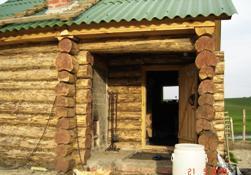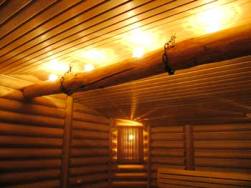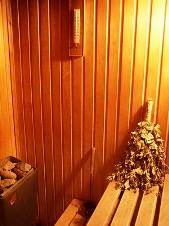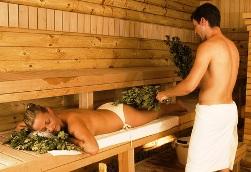Categories: Electrician Secrets, Electrician at home
Number of views: 77942
Comments on the article: 4
How to make wiring in a bath
 Practice gaskets electrical wiring for wooden buildings with wet rooms.
Practice gaskets electrical wiring for wooden buildings with wet rooms.
Increasingly, in order to equip everyday life in the country, people build not only residential buildings, but also farm buildings, saunas and gazebos. In the 21st century, no one can do without electricity, but wiring in a wooden house and a bath It has its own characteristics compared to a brick structure.
In the bathhouse, if it is a separate building, it is advisable to extend your line from the main switchboard, which is usually located in the house. This line should be protected by a separate machine.
Two wiring methods
There are two ways to run the power cable into the bathhouse. The first is "air", i.e. the cable goes through the air, the second is an underground cable. In both cases, there are advantages and disadvantages. Let's consider them in more detail. If you don’t like the “ropes” hanging over the plot, go straight to the second method.
Air way
So, with an air connection, if the distance to the bath is more than 25 meters, you need to put an intermediate support. If the cable passes over the carriageway, the cable height in the lowest place should not be less than 6 meters. If the cable passes over a pedestrian walkway, then the height should be more than 3.5 meters. When connecting to the building, the wires are fixed so that their height from the ground is more than 2.75 meters.
To connect, you must use self-supporting insulated cables, abbreviated SIP. These are cables of the SIP-2A, SIP-3, SIP-4 type with a guaranteed service life of 25 years. In reality, they serve much longer, because covered with special light-stabilized and weather-resistant polyethylene and have in their design load-bearing elements with high overload capacity.
 The cable cross-section must be at least 16 square millimeters, i.e. it can pass current up to 63 A. Such a current, with a single-phase connection, corresponds to a power of 14 kW, with a three-phase - 42 kW. This is more than enough for a bath. But SIPs have not only advantages, but also disadvantages. A vein of such a section is difficult to bend; it is rather difficult to introduce it directly into the circuit breakers.
The cable cross-section must be at least 16 square millimeters, i.e. it can pass current up to 63 A. Such a current, with a single-phase connection, corresponds to a power of 14 kW, with a three-phase - 42 kW. This is more than enough for a bath. But SIPs have not only advantages, but also disadvantages. A vein of such a section is difficult to bend; it is rather difficult to introduce it directly into the circuit breakers.
SIP is an aluminum wire, and cables made of aluminum cannot be routed through attic spaces. Therefore, when moving into a building, other cables are used. Usually this is VVG NG or NYM with a cross section of 10 square millimeters.
For the transition you need to use sealed copper-aluminum connectors, SIPs are mounted on special anchor clamps - tensioners. Entering into a wooden wall is done through a metal sleeve. All this is quite expensive. For example, the cheapest SIP-4 2x16 costs 23 rubles. per linear meter.
Earth way
If the cable does not pass through the neighboring area, and you have already carried out all the earthwork, then it is more reliable to lay the cable in the ground. For this, it is customary to use armored cables of the VBBSHV type with copper conductors with a cross section of 10 square millimeters. Such a cable of 4 cores with a cross section of 10 mm2 costs from 211 rubles. per linear meter.
The cable is more expensive and this is the main drawback. Mice and moles cannot bite this cable because between the inner and outer plastic sheath is a steel braid. Shrinkage of the earth is not afraid of him either.
 It is better not to use metal pipes for cable laying, as they collect condensate and the cable lies in the water, which reduces its lifespan. Metal pipes should be used if a cable runs down to and from the ground along a wall or pole. In this case, use a pipe or corner at least 1.8 meters high.
It is better not to use metal pipes for cable laying, as they collect condensate and the cable lies in the water, which reduces its lifespan. Metal pipes should be used if a cable runs down to and from the ground along a wall or pole. In this case, use a pipe or corner at least 1.8 meters high.
A cable trench with a depth of at least 0.7 meters (three bayonet shovels) is used for cable laying. Sand is poured into the bottom with a layer of 10 cm, from above the cable is also poured with a layer of sand, you can additionally make mechanical protection with bricks.
Entering into the building is also done through a steel sleeve.This protects the cable from damage during shrinkage and movement of the wooden wall. When entering the shield of the bath, the cable is released from the armor and the cable conductors are connected to the input machine. Desirable make local grounding and lightning protection.
Bath shield
The input machine and the required number are mounted in it difavtomatovmachines and RCDby dividing them into groups. Difavtomaty or automatic machines and RCD used for posting in wet rooms. RCD trip current is selected 10-30 mA. VVG wire is used for socketsng or NYM with a cross section of 2.5 square millimeters, for lighting the same wire with a cross section of 1.5 square millimeters.
Installation of sockets and switches
Sockets and switches are best not to be installed in humid rooms (washing and steam rooms). They should be placed only in the dressing room and rest room at a height of 80-90 cm from the floor. Sockets and switches selected with a protection class of at least IP-44 (with covers). It is better to take luminaires with protection class IP 54. The path to the devices should be as short as possible. In no case do not conduct wiring over the stove.
Secrets of posting
 Buy switches, sockets, junction boxes only in splash-proof design (IP-44 and above) for external wiring. The housing must cover the inside of the product from all sides. Input must be made from below, with the manufacture of a small U-shaped knee during entry. Then the condensate will not be able to leak into the product.
Buy switches, sockets, junction boxes only in splash-proof design (IP-44 and above) for external wiring. The housing must cover the inside of the product from all sides. Input must be made from below, with the manufacture of a small U-shaped knee during entry. Then the condensate will not be able to leak into the product.
All wiring to humid areas is done through diflift machines or RCDs with a cut-off current of 10-30 mA. You can also use low voltage (12-36 V) for lighting in such rooms, but this requires the installation of expensive transformers. You need to check the RCD once a month by clicking on the "Test" button.
Remember to check the wiring sometimes. Some “pets” like to chew on her. Good luck with the "light steam".
See also at bgv.electricianexp.com
:
